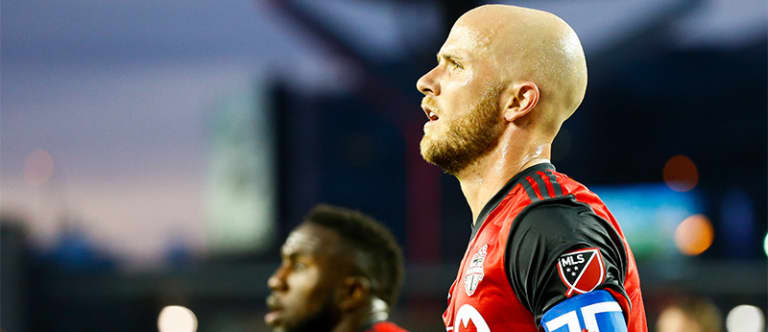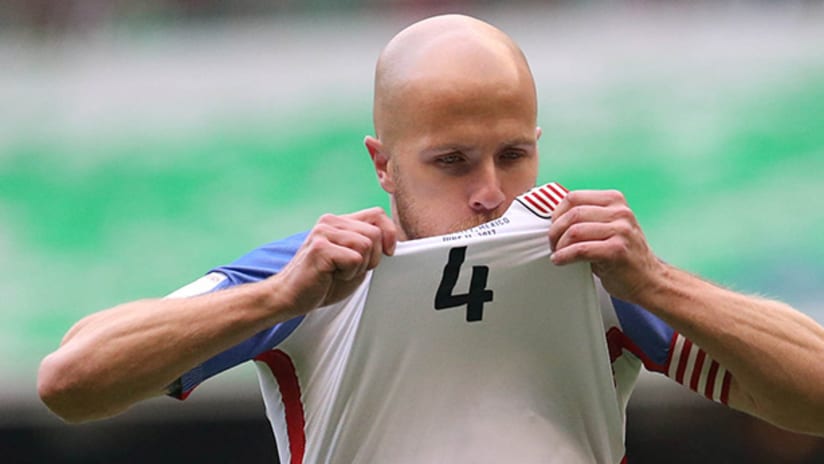It’s safe to assume Michael Bradley may never connect any sweeter than he did on a cool, overcast night in Mexico City on Sunday.
It’s difficult to fathom, as you watch the goal clip for the 20th and 21st time today, that the circumstances even came together to allow Bradley to score on a flat 50-yard chip that fell into the netting over helpless Mexico goalkeeper Memo Ochoa.
Start your morning off right. #USAvMEXhttps://t.co/kBoEOH1iVg
— Major League Soccer (@MLS) June 12, 2017
Mexico, which won 76 percent possession against the US in their World Cup qualifier on Sunday, were clearly not worried on that play. Or at least, not enough for Ochoa to closely guard his line as Mexico looked to pick its way forward through the US’s sagging midsection.
It was into this cauldron that Bradley carved out a wanton pass, broke open Mexico’s sleepy defense with a long touch and then swung through with a hybrid wedge to beat Ochoa and stun the 71,000 strong in the Estadio Azteca.
And for one play, the frequently dissenting voices that have surface around Bradley in recent years were silenced.
The evolution of Michael Bradley
In truth, Bradley’s reputation has undergone something of a transformation in the last few years.
If we use Bradley wondergoals as bookends, the time between his last blindingly beautiful goal against Scotland in 2012 and the one he scored Sunday to ensure a vital 1-1 draw in Mexico has been contentiously debated.
His roles shifted like putty for club and country, and so too did his utility seem to morph. How do we even come to understand the modern tactical Bradley when it seems as though the clay of his career has been shaped by so many disparate hands at abrupt odds with one another?
As I see it, Bradley is the most tragically misunderstood USMNT player of his generation. And he’s quietly been the singular player the US can’t do without, especially in overheated road matches when his cool, collected leadership is so desperately required.
It's generally accepted that Bradley came into his own on the club level around 2011-2014, when he was sitting deep in Italy for Chievo and Roma. Even before he arrived in Italy, Bradley was a thoroughly Italian midfielder. His preferred playstyle has always carefully mirrored his clipped, thoughtful demeanor cribbed so naturally from his stern, intentional father Bob.
Italy was good to Bradley because Serie A tends to slow down pace to a more ponderous degree. Bradley thrived as a deep-lying midfielder building attacks and simultaneously crushing them while being able to access the more prosaic corners of his tactical intellect. He had the time to do it in Italy.
The problems began to first creep into the equation under then-US coach Jurgen Klinsmann. Bradley has always been the most obviously comfortable deep with a covering midfielder slightly akimbo upfield. Bradley, ever the watchful builder, prefers to drop in and collect from the defense, but he also requires a short outlet to provide a backboard for the initial bricks in the wall. For the majority of his five years as US coach, Klinsmann saw Bradley either as a barnstorming box-to-box midfielder or as an out-and-out No. 10.
He is neither of these things.

When Bradley moved to Toronto FC in 2014, then coach Ryan Nelsen used Bradley similarly, not as a No. 10 but as a sort of do-everything central engine. Bradley is good enough in the latter role, but it takes him away from the sort of game he prefers; smart, low-risk, tightly controlled. Instead, suddenly he was asked to prod into attacking thirds with regularity and challenge center backs. It worked in its fashion, but anyone with eyes could see it was an awkward fit, like a bear asked to run with cheetahs.
This has been the way of it for the last three years, and Bradley’s been battered by public opinion in the interim. One imagines it’s intimately frustrating for the former MetroStar, who’s dutifully filled awkward roles outside his best use the last couple years and performed better in them than anyone should reasonably expect.
As perhaps the most obvious example, Bradley covered more physical ground than any player at the 2014 World Cup. It’s hard to stress vehemently enough how much this is not Bradley’s wheelhouse. His mistakes compounded only because his eyes were on four different positions, most of them strange fits.
Bruce Arena re-entered the USMNT stage late last year with fewer notions about specific fits divorced from the players’ own opinions of themselves. This is partly why Bradley’s returned to the sitting No. 6 role over the last six months, and why he’s suddenly looked more comfortable than he has in a US shirt in years.
A system that works for Bradley

There is also the matter of central partnership. Jermaine Jones, Bradley’s most common companion in the middle, has his unique merits but few of them jive with Bradley’s.
Jones’ history as a nomad is utterly at odds with Bradley’s more staid patterns, and when Jones ran, Bradley was invariably left holding the bag. Many of Bradley's mistakes in space are down to his lack of a possession backboard. As any coach worth his salt will tell you, the most important facet to unlocking a player is first knowing their strengths and weaknesses. But it’s ultimately a useless endeavor if you don’t play into the former to avoid the latter.
Bradley is not blameless in all this, of course. His passing efficiency has objectively dropped in the last few years for the national team, but at least the last few games proved his boat is shifting tack into more placid waters. On Thursday, in a 2-0 qualifying win over Trinidad and Tobago, it was Bradley’s pressure and subsequent forced turnover up the middle that started the movement toward Christian Pulisic’s opener. And of course his quick read of the situation on Sunday night against Mexico – a thousand minute calculations processed and spat out in a matter of seconds – led to one of the most sublime goals you’ll ever see.
In both scenarios he was leaning back into his preferred position in a system that suddenly allowed him to pick his moments forward instead of thrusting him into the fray at will. One works with Bradley and the latter mostly does not.
Allowing Bradley the freedom to hang back also has notably positive defensive consequences. On Sunday, Bradley only even attempted three passes in Mexico’s half, as much a product of his evolved role as it was the US’s lack of impetus in the attack. But it also gave him the ability to recover on Mexico attacks more quickly, a huge demerit against him when he’s forced forward. He’s simply not fast enough to be all that effective on the recovery, one of the reasons that a role as a dedicated attacker is so strange for him.
Instead, against Mexico, Bradley was in position to register a whopping five clearances in the box, several of them critical to save vital goal-scoring opportunities. Bradley’s never been one to go in hard and low, but if you position him correctly, none of that really matters. He’s in place to cut off the attack without ever having to go to ground in the first place.
Arena’s next frontier with Bradley is finding him that central outlet, and it may have fallen on him against Mexico. Young Kellyn Acosta grew into the game dramatically after earning the start as Bradley’s running mate, and the two looked like old friends by the time the game ended.
Acosta is just the sort of reliable pairing Bradley had earlier in his career, and in the long run, as the US drives toward Russia 2018, it would make an immense amount of sense to continue their run at familiarity.
Bradley is ever the dutiful captain, willing as he’s been to swallow awkward roles in awkwardly fitting formations while refusing public complaint. In this he’s taken his hits, although I’ve never gotten the sense it cracked his thoughtful veneer.
Now that he’s finally returning to his roots on the national team scene, perhaps the shackles are finally falling away.
ExtraTime Radio Podcast

LISTEN: A timeless goal and result for Michael Bradley and the US national team has the guys in a good mood. Come for the analysis and banter and stay for a must-listen interview with Tyler Adams, fresh off his senior prom and looking forward to the NYC Derby (and maybe even a first-team call-up sooner rather than later). Subscribe so you never miss a show!













